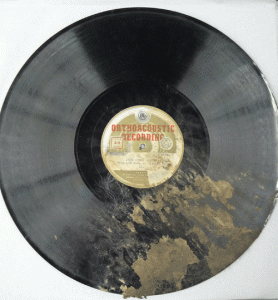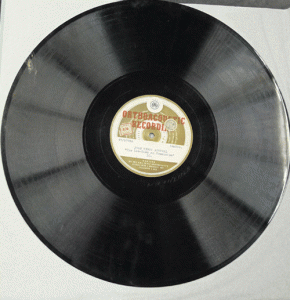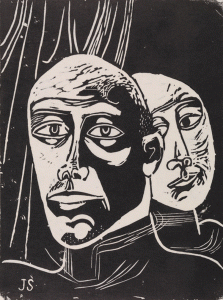Historical Records
The University of Melbourne Archives has recently digitised and made available online a unique collection of recordings of political advertisements from the 1949 federal election campaign. The recordings are from the ‘John Henry Austral’ advertising campaign run by the Liberal Party of Australia in 1948 and 1949. The 13 records comprise 22 episodes including the first five episodes broadcast. These records have undergone conservation treatment (see images above for a before and after shot of the episode ‘Low Down on Communism’) and have been digitised and are available on the University Library’s Digital Repository.
The John Henry Austral program was the centrepiece of the Liberal Party’s public relations campaign in the 1949 federal election. It was created by Solomon (Sim) Rubensohn of the Hansen-Rubensohn advertising firm, written by Percy (Pip) Cogger and the character of Austral was performed by Richard Matthews. The episodes began airing in February 1948 and continued through to the election in December 1949. There were around 200 episodes broadcast on over 80 commercial radio stations throughout Australia. The Liberal Party budgeted £2,300 per month for the broadcasts, making the campaign one of the most expensive in relative terms in Australian history.
The program is regarded as significant in the history of Australian political campaigns because of its centralised structure, its format and its apparent success. Each episode ran for 15 minutes, in the format of a dramatised radio serial. It featured the ‘neighbourly but knowledgeable’ John Henry Austral, who, through dramatisations and dialogues with friends and acquaintances, expounded the Liberal vision for Australia and the perceived failings of the federal Labor government. Many of the episodes focus on the threat of communism and Labor’s apparent weakness in the face of this threat, and its ‘socialist’ leanings. But other issues include high prices and rationing, women’s issues, bank nationalisation and socialisation, education, the role of the British Empire, the activities of youth, the black market and class antagonisms at work.
It is believed that the University of Melbourne Archives holds the only extant copies of the John Henry Austral recordings. There is a complete set of scripts of the program held at the State Library of NSW (call number Q329.2/15-16) and other information in the National Library of Australia’s RG Casey collection (NLA MS 6150). Because the program was dramatised, considerable use was made of accents, and music that are can only be appreciated in the recordings themselves.
Now these gramophone records have been digitised and the episodes available online, modern audiences can now hear and appreciate what is still regarded as a groundbreaking political campaign in Australian politics.






